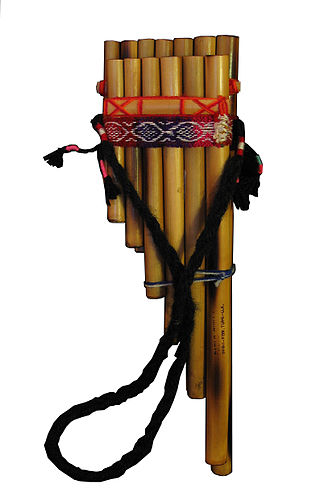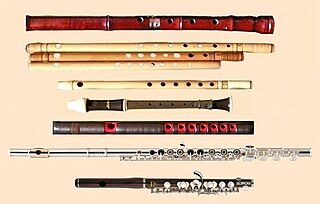
A pan flute is a musical instrument based on the principle of the closed tube, consisting of multiple pipes of gradually increasing length. Multiple varieties of pan flutes have been popular as folk instruments. The pipes are typically made from bamboo, giant cane, or local reeds. Other materials include wood, plastic, metal, and clay.

An aerophone is a musical instrument that produces sound primarily by causing a body of air to vibrate, without the use of strings or membranes, and without the vibration of the instrument itself adding considerably to the sound.

The Warm Springs Indian Reservation consists of 1,019 square miles (2,640 km2) in north-central Oregon, in the United States, and is governed by the Confederated Tribes of Warm Springs.

Indigenous music of North America, which includes American Indian music or Native American music, is the music that is used, created or performed by Indigenous peoples of North America, including Native Americans in the United States and Aboriginal peoples in Canada, Indigenous peoples of Mexico, and other North American countries—especially traditional tribal music, such as Pueblo music and Inuit music. In addition to the traditional music of the Native American groups, there now exist pan-Indianism and intertribal genres as well as distinct Native American subgenres of popular music including: rock, blues, hip hop, classical, film music, and reggae, as well as unique popular styles like chicken scratch and New Mexico music.

John Trudell was a Native American author, poet, actor, musician, and political activist. He was the spokesperson for the Indians of All Tribes' takeover of Alcatraz beginning in 1969, broadcasting as Radio Free Alcatraz. During most of the 1970s, he served as the chairman of the American Indian Movement, based in Minneapolis, Minnesota.

The Confederated Tribes of the Umatilla Indian Reservation are the federally recognized confederations of three Sahaptin-speaking Native American tribes who traditionally inhabited the Columbia River Plateau region: the Cayuse, Umatilla, and Walla Walla.

Raymond Carlos Nakai is a Native American flutist of Navajo and Ute heritage. Nakai played brass instruments in high school and college, and auditioned for the Armed Forces School of Music after a two-year period in the United States Navy. He began playing a traditional Native American cedar flute after an accident left him unable to play the trumpet. Largely self-taught, he released his first album Changes in 1983, and afterward signed a contract with Canyon Records, who produced more than thirty of his albums in subsequent years. His music prominently features original compositions for the flute inspired by traditional Native American melodies. Nakai has collaborated with musicians William Eaton, Peter Kater, Philip Glass, Nawang Khechog, Paul Horn, and Keola Beamer. He has received 11 Grammy Award nominations for his albums.

The Confederated Tribes of the Grand Ronde Community of Oregon (CTGR) is a federally recognized tribe of Indigenous peoples of the Northwest Plateau. They consist of at least 27 Native American tribes with long historical ties to present-day western Oregon between the western boundary of the Oregon Coast and the eastern boundary of the Cascade Range, and the northern boundary of southwestern Washington and the southern boundary of northern California.
The Native American flute is a musical instrument and flute that is held in front of the player, has open finger holes, and has two chambers: one for collecting the breath of the player and a second chamber which creates sound. The player breathes into one end of the flute without the need for an embouchure. A block on the outside of the instrument directs the player's breath from the first chamber—called the slow air chamber—into the second chamber—called the sound chamber. The design of a sound hole at the proximal end of the sound chamber causes air from the player's breath to vibrate. This vibration causes a steady resonance of air pressure in the sound chamber that creates sound.
Bill Miller is a Native American singer/songwriter and artist of Mohican heritage. He is a guitarist, player of the Native American flute and painter.
Brulé & AIRO is a contemporary Native American new-age/worldbeat music group based in South Dakota. They have sold over one million CDs worldwide, won a number of awards, and have made media appearances with the Live with Regis and Kathie Lee television show, CNN WorldBeat, QVC, and others. They maintain a schedule of well over 100 performances a year including full stage productions with traditional dancers, an annual holiday tour, performances at Milwaukee's Indian Summer Festival, Indian Art Markets in Denver, Arlington (Tx.), and Overland Park, Kansas, Harbor Fest in Virginia Beach, the world-renowned Ordway Theater in St. Paul, Foxwoods Casino, and many additional outdoor festivals and events. They have released 22 CDs over their 21-year existence.

Mary Youngblood is an American musician and performer of the Native American flute.
Michael John Murphy is a folk musician based in Omaha, Nebraska. He plays various instruments, including the guitar, piano, and Native American flute. He has been a singer songwriter based out of Omaha since the 1970s.

Kevin Edward Locke was of Lakota descent of the Standing Rock Sioux Tribe and Anishinaabe of White Earth. He was a preeminent player of the North American Indigenous Flute, a traditional storyteller, cultural ambassador, recording artist and educator. He was best-known for his hoop dance, The Hoop of Life.

Robert Mirabal is a Pueblo musician and Native American flute player and maker from Taos Pueblo, New Mexico.
Peter Kater is a German-born American pianist, composer and Grammy Award winner.
Canyon Records of Phoenix, Arizona, is a record label that has produced and distributed Native American music for 56 years.

The Confederated Tribes of Warm Springs is a federally recognized Native American tribe made of three tribes who put together a confederation. They live on and govern the Warm Springs Indian Reservation in the U.S. state of Oregon.

A flute circle is an organization of musicians which focuses on the Native American flute. Flute circles typically meet periodically to engage in educational and recreational activities surrounding the instrument. Most flute circles offer instruction on the Native American flute, especially for flutists who are new to the instrument. Many flute circles have a facilitator with experience in group music facilitation and humanistic music education to structure the activities and the music-making.
This is a discography of Native American flute player R. Carlos Nakai.













